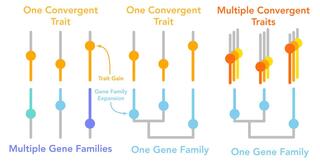Convergent expansions of keystone gene families drive metabolic innovation in Saccharomycotina yeasts
K.T. David et al. "Convergent expansions of keystone gene families drive metabolic innovation in Saccharomycotina yeasts" PNAS (2025) 122:e2500165122 [DOI:10.1073/pnas.2500165122]
Many remarkable phenotypes have repeatedly occurred across vast evolutionary distances. When convergent traits emerge on the tree of life, they are sometimes driven by the same underlying gene families, while other times, many different gene families are involved. Conversely, a gene family may be repeatedly recruited for a single trait or many different traits. To understand the general rules governing convergence at both genomic and phenotypic levels, we systematically tested associations between 56 binary metabolic traits and gene count in 14,785 gene families from 993 Saccharomycotina yeasts. Using a recently developed phylogenetic approach that reduces spurious correlations, we found that gene family expansion and contraction were significantly linked to trait gain and loss in 45/56 (80%) traits. While 595/739 (81%) significant gene families were associated with only one trait, we also identified several "keystone" gene families that were significantly associated with up to 13/56 (23%) of all traits. Strikingly, most of these families are known to encode metabolic enzymes and transporters, including all members of the industrially relevant MAL tose fermentation loci in the baker's yeast Saccharomyces cerevisiae. These results indicate that convergent evolution on the gene family level may be more widespread across deeper timescales than previously believed.
Data have been deposited in Figshare and GitHub. The data are available at [Figshare (https://doi.org/10.6084/m9.figshare.26440963) (69) and Github (https://github.com/KyleTDavid/YeastConvergence2025) (70)] [data (https://doi.org/10.6084/m9.figshare.26440963) and code (https://github.com/KyleTDavid/YeastConvergence2024)].
